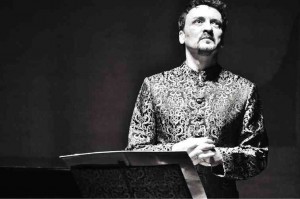
The music of the zarzuela, the Spanish dramatic musical theater, took center stage recently at the Little Theater of the Cultural Center of the Philippines, featuring the collaborative tandem of Spanish performing artists.
Tenor Enrique Viana, schooled in the bel-canto tradition, and Daniel Oyarzabal, an accomplished pianist, teamed up for a delightful evening of Spanish songs.
Sponsored by the Spanish Embassy, Instituto Cervantes de Manila, and CCP, the concert was a highlight of the celebration of the Philippine-Spanish Friendship Week.
The concert afforded Manila’s music lovers an opportunity to appreciate a sampling of songs culled from different Spanish zarzuelas from the first three decades of the 20th century.
The zarzuela, of course, had taken firm roots in the country and became popular especially during the American period. Known as sarswela, it was popular entertainment of the people, staged widely in the country.
Mirroring society
The concert was actually an “informance” (information plus performance). Viana, did a splendid task of briefing the audience on the the genre before singing the featured songs.
In his introductory remarks, the singer said the zarzuela was “the genre which best depicts the Spanish spirit, its customs, traditions, culture and feelings through music.”
He added that indigenous elements such as the Jota or seguidilla merge with other musical forms from other lands such as the waltz, mazurkas or habanera, thus enriching the music.
Spanish writers who wrote the librettos had focused their texts on practically all aspects of Spanish life, the ordinary and the historical, as well as comical situations, romance and the like.
The zarzuela therefore mirrors society. The songs are scored to precisely dish out appropriate emotions. They are calculated to tug at the heart. And because the musical language is derived from the people, the zarzuela has become an important part of Spain’s cultural life.
7 works
Songs and piano solos from seven works were rendered without break or interval. They were: Federico Torroba’s “Luisa Fernanda” (1932) and “La Chulapona”; Pablo Sorozabal’s “Katiuska” (1931) and “La Tabernera del Puerto” (1936); Manuel Penella’s “Don Gil de Alcala” (1932); Jose Serrano’s “Alma de Dios” (1907); and Amadeo Vives’ “Doña Francisquita” (1923).
“Luisa Fernanda” is a historical zarzuela centered on the Spanish Revolution in 1868 that saw the ouster of Queen Isabel ll.
It was followed by yet another zarzuela on revolution, this time the Russian Revolution of 1917.
The comical genre is embodied in “Don Gil de Alcala,” and a depiction of the ordinary life is typified in “Alma de Dios.”
Romance is exemplified in “La Taberna del Puerto.” Madrid is the setting of “La Chupalona” and “Doña Francisquita.”
There is oneness of the music and text. The music paints the moods, colors and sentiments that the texts convey.
Viana sang the songs warmly. Obviously the voice was bel canto: placed on the masque, legato and resonant. Though done with effort, he gave his high notes with elan.
Despite the narration, the singer’s voice did not show tiredness, and remained fresh throughout. A glass of water stood on the lid of the piano that was closed, for excellent balance effect.
The singer would sip water from the glass and wet his throat, so to speak, before singing after giving each narration. He touched his songs with wit and he cut a strong presence throughout.
“No Puede Ser” from “La Taberna del Puerto” elicited the loudest applause, as the song, as correctly stated by the singer, has remained an all-out favorite since it was first heard more than seven decades ago.
Strong presence
On the piano, Oyarzabal also cut a strong presence. His tones were even, and struck balance with the song.
The singer and the pianist forged a strong oneness in their rendition, making the performance truly collaborative.
The audience easily related with the gentle undulation of the popular habanera rhythm the pianist dished out from his solo rendition of “Don Gil de Alcala”
The singer anchored the popular “Dahil sa Iyo” by Velarde. He prefaced his singing by saying Filipino songs were very melodic. Both singer and pianist were at home rendering this piece. They showed a familiarity rooted in a musical tradition common to both the colonial mother, Spain, and a treasured colony, the Philippines.
Spanish music, after all, has become part of the vibrant musical fabric of the Philippines.